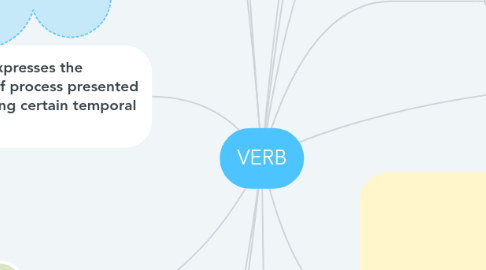
1. PHRASAL VERBS
1.1. analytical
1.1.1. head-verb "have", "give", "take" and some others + noun
1.1.2. head-verb with a verbal postposition
1.2. syntactic
2. CLASSES
2.1. full nominative (notional verbs) => derivationally open *subject process relations
2.1.1. actional
2.1.1.1. express the action perfomed by the subject, that is they present the subject as a doer
2.1.1.1.1. act, do, perform, make, go, read etc.
2.1.2. statal
2.1.2.1. denote the state of their subject
2.1.2.1.1. be, live, worry,see, know, suffer etc.
2.1.3. "processes"
2.1.3.1. mental
2.1.3.2. sensual
2.1.3.3. *aspective correlation between the verb of perception and physical perceptional activity *power of the verb in relation to other notional words in the utterance
2.2. partial nominative (semi-notional & functional) => derivationally closed
2.2.1. auxilary verbs
2.2.1.1. *constitute part of the analytical forms of the verb as purely grammatical element *their meaning is completely lost
2.2.2. modal verbs
2.2.2.1. express the agent's attitude to the action, thus this attitude constitutes their semantics
2.2.3. semi-notional verbid inroducer verbs
2.2.3.1. are distributed among the verbal sets
2.2.3.1.1. of discriminatory relational semantics
2.2.3.1.2. of subject-action relational semantics
2.2.3.1.3. of phrasal semantics
2.2.4. link verbs
2.2.4.1. expose the relational aspect of the characteristicsascribed by the predicative to the subject
3. person & number SUBSYSTEMS (Presenr Tense)
3.1. modal verbs that have no personal inflexions
3.1.1. -can -dare -need -must -may -ought -will
3.2. verbal lexem "be"
3.2.1. -am -is -are
3.3. -(e)s
4. CATEGORIES
4.1. the category of retrospective coordination
4.1.1. perfect - non perfect opposition
4.2. the aspective category of development
4.2.1. continuous - indefinite opposition while clauses
5. a part of speech that expresses the grammatical meaning of process presented dynamically, i.e. as having certain temporal dimensions
6. The Category of Mood
6.1. expreeses the character of connection between the process denoted by the verb and the actusl realitu
6.1.1. subjunctive I - spective (be, live) <=speculate
6.1.2. subjunctive II - stipulative (past forms) <=stipulate
6.1.3. subjunctive III - consective (should/would + inf.) <=consequence
6.1.4. subjunctive IV - modal subjunctive (might/should/let + inf.)
7. finite
7.1. verb-predicate function
8. non-finite
8.1. potentialy predicative function
9. ASPECTUAL MEANINGS
9.1. verbs of ingression
9.2. verbsa of instantaneity
9.3. verbs of termination
9.4. verbs of duration
10. ASPECTIVE DIVISION
10.1. limitive (terminative)
10.1.1. arrive, come, leave
10.2. unlimitive (non-terminative)
10.2.1. move, continue, live
10.3. verbs of double nature
11. The Category of Tense Time Denotation
11.1. absolutive
11.1.1. the sphere of present
11.1.2. the sphere of past
11.1.3. the sphere of future
11.1.3.1. means of expressing the future: -shall/will + infinitive -to be going to
11.1.4. now, last week, in the past, very soon etc.
11.2. non-absolutive
11.2.1. relative
11.2.1.1. events either proceeding or following the others
11.2.1.1.1. before that, sone time later etc.
11.2.2. factual
11.2.2.1. states the astronomial time of event
11.2.2.1.1. at the epoch of Napoleon, in 1066 etc.
12. ASPECT
12.1. limitive/unlimitive
12.2. continuous/non-continuous
12.3. perfect/non-perfect
13. VOICE
13.1. passive
13.2. active
13.3. English
13.3.1. transitive
13.3.2. intarnsitive
13.4. Russian
13.4.1. transitive
13.5. Problems
13.5.1. "Medial" voices
13.5.2. Reflexive voices + reflexive pronoun
13.5.3. Reciprocal voices + reciprocal pronoun

